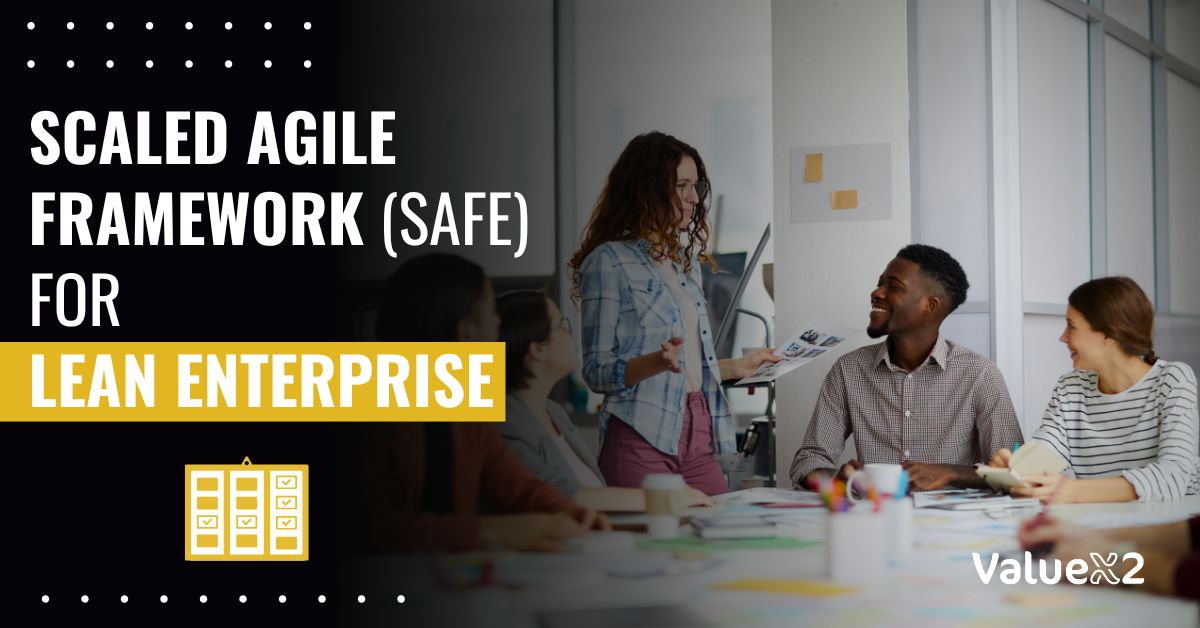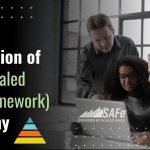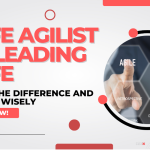Discover how SAFe for Lean Enterprises helps organizations get to agility, integration, and continuous value realization! This extensive run-through details its principles and their application in an organization from the basics. Thereby showing how the SAFe for Lean Enterprises methodology can help an organization.

Introduction
With increasing competition and globalisation, large enterprises have to face certain challenges in their workplace. To counter these challenges, they need competent and cross-functional teams and effective customer value delivery. Standard approaches are inadequate for organisations once they become large and sophisticated. This is when Agile scaling comes into play.
It gives the frameworks and approaches to scale Agile values from beyond the team level and enable the whole organisation. Of all the solutions that can help in Agile scaling, SAFe (Scaled Agile Framework) is one of the most popular.
In this article, we will discuss various aspects of SAFe for Lean Enterprises beginning with the basics such as the principles and components of SAFe. We will also look at the business benefits of SAFe for Lean enterprises including faster delivery, better quality, and customer satisfaction.
Understanding SAFe and Lean Enterprises
What is SAFe?
SAFe is a large-scale framework developed to implement Agile in large organisations. It offers a framework to ensure Agile is implemented in an organised manner to cover large projects when there are many teams involved in service delivery.
The main goals of SAFe include:
- Fostering Agile adoption: SAFe is vital as it assists organisations in incorporating Agile principles into their functions. It offers frameworks that can enable the incorporation of Agile throughout the organisation.
- Creating alignment: It makes all the formations, teams, departments and leadership vision as one in achieving set goals and objectives.
- Ensuring continuous value delivery: By breaking work into smaller chunks, SAFe encourages fast and effective delivery, highly appreciated by customers.
Agile is perceived as being most effective when implemented at different levels and across all sections of an organisation. Thus, SAFe is fundamental for organisations that strive to remain relevant in constantly shifting markets.
What is a Lean Enterprise?
A Lean Enterprise is a business venture that aims at delivering an organisation’s goods and services to customers efficiently and reducing waste generation in the process. It is derived from the Lean management movement, whose goal is to optimise practices, reduce wastes and improve gradual enhancement.
Key aspects of a Lean Enterprise include:
- Efficiency: The pressure to get more done for less and at the same time offer high quality.
- Value delivery: Ensuring that all the operation and all the effort put in by the organisation brings value addition to the customer.
- Waste reduction: Eliminating any steps in a process that will not bring it to its conclusion.
The Lean approach updates organisations continuously, enhances decision-making, and establishes a culture of organisational learning.
How Does SAFe for Lean Enterprises Help the Organizations?
Being an effective framework, SAFe enriches Lean techniques, making it an ideal tool for building a Lean Enterprise. Here’s how:
- Focusing on Value Streams
SAFe structure works according to value streams, which are the series of processes that must occur to deliver value. This ensures that teams focus on working on the kind of results that will be valuable to the whole organisation. The utilisation of SAFe for Lean Enterprises therefore helps an organisation to deliver value more fast and effectively.
- Reducing Bottlenecks
One of the major issues that are difficult to avoid in large organisations is that certain processes may slow when bottlenecks develop. SAFe recognizes such constraints and has solutions to removing them. For instance, the SAFe Lean-Agile Principles encourage people to work in unison throughout a given project’s lifecycle and foster communication transparency that helps the teams work through any issue that may cause any delay.
- Managing Workflows from End to End
SAFe works towards the improvement of the programs by aligning the workflow of an organisation. This includes Agile practice application in the planning, implementation and delivery of agendas, etc. Teams are trained to take assessments, determine the deficits as well as effect changes effectively.
Foundations of SAFe for Lean Enterprises
SAFe Lean-Agile Principles, on which the Scaled Agile framework is based, help to clarify direction in the areas of alignment, quality, transparency, program efficiency, and leadership for improvement. These provide the foundation of SAFe for Lean Enterprises, which provides important business benefits that an organisation may derive.
Alignment
All the levels of an organisation must be in harmony with other tiers of management, such that the teamwork is aligned with executive objectives. This supports organisations to stay on course as they implement change in the marketplace insightfully. Any program that aims to achieve SAFe certification would benefit from this type of cognitive understanding of how alignment drives and strengthens organisational coordination.
Built-in Quality
Team members should ensure that every subsequent increment of work is delivered to a high standard. The danger of technical debt and subsequent expensive rework is reduced in SAFe by integrating quality into all phases of development.
The work is often organised with an optimal set of practices applied to the teams so that products and solutions guarantee the best value. This focus on quality is necessary to help realise the longer-term business advantages that SAFe offers for Lean enterprises.
Transparency
Being a part of an organisational work culture increases visibility in every aspect of an organisation. SAFe exempts practices such as updating one another frequently, sharing progress and communicating transparently as negative.
It enhances trust that is vital between different teams and leadership levels to solve issues relating to projects consequently. Transparency is also an integral part of the SAFe Lean-Agile Principles since it expects everybody to be on the same page as the organisation.
Program Execution
Program execution deals with incrementally and predictably delivering value. The framework brings in Agile Release Trains (ARTs), focused on developing and delivering solutions. Due to the systematic way of implementing the SAFe programme, the framework helps organisations to achieve given goals and enhance their productivity. For people who want to apply for the Scaled Agile Framework certification, one must learn how the SAFe works through the program execution.
Lean Agile Leadership
Lean-Agile Leadership is central to the operation of SAFe. Managers are the role models driving the Agile change and possessing a mentality based on Lean and Agile values. They challenge the teams to set good examples by adapting to change, continually coming up with creativity and providing value.
One of the biggest business values of SAFe for Lean Enterprises is outstanding leadership as this approach helps to avoid issues and maintain continued success.
Key Components of SAFe for Lean Enterprises
SAFe helps to keep business aligned and integrated, clear and consistently deliver customer value. The following sub-sections examine the fundamental, architectural, and purpose of SAFe, with an emphasis on the SAFe Lean-Agile Principles; Scaled Agile Framework certification; and business value of SAFe for Lean Enterprises.
SAFe’s Four Configurations
- Essential SAFe
The base configuration, known as Essential SAFe, targets ARTs and coordination at the program level. This configuration contains only elements necessary for an organisation, thus being appropriate for startups that decide to go Agile. Organisation advantages of implementing SAFe for Lean Enterprises include; enhanced team cooperation, integrated processes, and reliable schedules.
- Large Solution SAFe
For enterprises developing massive solutions with combined abilities of multiple ARTs, Large Solution SAFe serves as the model. This configuration caters for giant systems which cannot otherwise be developed by single teams.
It accommodates stakeholders, dependencies, and flows in the approach dealing with complex solutions. Using this arrangement, organisations can operate efficiently, effectively and with the highest quality to satisfy the customers.
- Portfolio SAFe
Portfolio SAFe is an approach that supports Agile execution for portfolio value streams as well as lean budgeting. This configuration controls the investments and makes sure that the organisation gets the most out of the resources it provides. This way, it offers a business an opportunity to stay on track with its strategic goals and objectives while at the same time affording latitude and opportunity for creativity.
- Full SAFe
Full SAFe is embedded with all configurations, thus making it possible for enterprises to scale up on the Agile practices. It is especially useful when applied to extensive companies that demand complicated synchronisation from teams to portfolios.
The business value that reaches Lean Enterprises when employing SAFe in this configuration is better agility, faster delivery, and the existence of a common organisational vision.
SAFe’s Structural Elements
- Agile Release Train (ART)
The Agile Release Train is a collection of several Agile groups that provide value across the ART. ART runs on a repetitive cycle to guarantee that organisations are in harmony in terms of purpose and focus. Being a part of the ART encourages integration, program delivery predictability, and a culture of relentless improvement, in keeping with the SAFe Lean-Agile Principles.
- Value Streams
A value stream refers to the sequence through which value reaches the customer. So when organisations define and optimise these avenues of work, then there will be little or no waste as they will achieve their intended goal. Value streams help organisations to get to customer value delivery networks to provide customers with products that they need.
- Program Increment (PI)
Program Increment is a time of 8-12 weeks when planning, performing and delivering several features is called Program Increment. PI planning helps the team operate in a way that will be consistent with the goals set by the organisation by increasing accountability to others. It also gives a framework for priming and steering change as well as a prop to keep sight of the general goal.
- Portfolio Level
At the Portfolio Level, businesses keep and achieve strategic goals through lean operating costs and constant optimization. They rely on this level to ensure that any project undertaken meets the aims and objectives of the business, and comes with maximum benefits. It always provides organisations with the necessary competitive and responsive approach in the given markets.
What are the Different Roles Offered in SAFe for Lean Enterprises?
- Release Train Engineer (RTE)
Release Train Engineer (RTE) is a servant leader and a coach to the ART as well. They organise ART events, clear log jams and contribute to the efficiency of programme delivery.
With regard to the main business value of SAFe for Lean Enterprises, the RTE is, therefore, instrumental in ensuring the key process improvements identified in this paper by establishing and maintaining collaboration, and by doing away with barriers to efficient workflow.
- Product Manager
The Product Manager owns the program backlog and its role centres around the delivery of customer solutions. They have regular interactions with the customers to set the vision of the product, find out what is essential in a new product, and most importantly, assess how a product affects business interests. They are crucial in providing interpretation of customer needs into work assignments for the teams.
- System Architect/Engineer
The System Architect/Engineer is to give technical inputs so that the solution fulfils the quality and performance criteria. They prescribe the architecture, set standards in design, and assist teams in constructing solutions that are elastic. This role guarantees that the technical aspects of the framework respect the mentioned SAFe Lean-Agile Principles.
Business Benefits of SAFe for Lean Enterprises
Thus, through collaboration, understanding of agility, and focus on the delivery of values, SAFe embraces enterprises and helps them meet market challenges. Below are the core benefits of SAFe for Lean Enterprises:
Improved cross-functional collaboration.
SAFe for Lean Enterprises promises its business audience an emphasis on cross-team communication. Normally, it is observed that many big companies have departments and teams that are often segregated, thus reducing productivity. SAFe removes these barriers by ensuring all the teams are working towards the same goals and objectives.
When adopting SAFe Lean-Agile, availability and coordination benefit and are resolved more quickly through Lean-Agile principles. This means that collaboration becomes the standard in any project to create a fluid process.
Increased Agility at Scale
SAFe supplies guidelines that allow the implementation of agility at the organisational level in order to achieve fast reactions to customer needs or changes in the market.
SAFe is a Lean-Agile business and enterprise solution that helps enterprises manage the costs of multiple groups and organise changes efficiently. It mostly helps businesses to remain competitive because they change them for the better and make them more responsive.
Streamlined Value Delivery
SAFe breaks work into value streams which guarantee that all work performed opposes business value. Agile Release Trains (ARTs) and Program Increments (PIs) are rather formal frameworks for implementing value delivery.
Divisions work in projects and projects work in segments, thereby lowering the chances of distorted goals or schedule failure. It allows organisations to better satisfy customer needs and wants while at the same time not jeopardising quality. Lean Enterprises operating with SAFe observe a significant enhancement in prioritising and delivering what is important.
Enhanced Strategic Alignment
A key concept of SAFe Lean-Agile is strategic alignment. At the portfolio level, SAFe focuses on integrating all the teams and projects with the goal of the organisation. Portfolio governance in SAFe helps make certain that every portfolio element contributes maximum value.
This alignment is realised through status and updates to the portfolio backlog by the leaders to align with business requirements. Employees within organisations have realised how their processes fit into bigger organisational objectives. Companies have found it easier to sustain this alignment especially if they have personnel trained via Scaled Agile Framework certification.
Implementing SAFe for Lean Enterprises: A Step-by-Step Guide
The Scaled Agile Framework (SAFe) for Lean Enterprises addresses suggestions for the adoption of lean-agile within large enterprises. With these guidelines in mind, organisations can fully implement the benefits of agile approaches, foster closer alignment, increase velocity and enhance performance.
Step 1: Learn and Teach SAFe Principles
- Align Leadership: Make sure that all leadership engages in SAFe, and knows what Lean-Agile means, which is the foundation of SAFe.
- Clear Communication: Provide the foundation ideas of SAFe to show every member of an organisation that they are on the same page; this includes embracing change, teaming, and only continuous delivery of value.
- Use SAFe Training: Educate leaders, managers, and teams about the Scaled Agile Framework, and the proper way of implementing it in the organisation, and offer certification programs.
- Highlight Benefits: Stress the business benefits of SAFe for Lean Enterprises, namely providing faster delivery, enhanced quality and capacity to respond to market conditions.
Step 2: Set Up Agile Release Trains (ARTs)
- Identify Value Streams: Specify what value streams are, which will determine the flow of value from suggestion to delivery.
- Align Teams: Take care to insulate each team within the ART to work towards goals that align with the value stream.
- Establish Regular Cadence: Establish regularity of ARTs where they effectively create value, allowing structure and frequency that teams can reliably deliver in small amounts, but with continuous improvements.
- Provide Support: Make sure ARTs possess adequate resources and access to leadership to complete the tasks without any hindrance and direction on how to collaborate with the team.
Step 3: Start Program Increment (PI) Planning
- Organise PI Planning Events: Organise PI planning meetings which happen every 8-12 weeks where all the teams in an ART need to agree on goals as well as objectives of an increment.
- Set Clear Objectives: When planning for the PI, ensure that the team defines what will be delivered, and map this against business goals, creating visibility for all the teams.
- Collaborate and Plan: Depending on the PI goals, all teams should cooperate to schedule overall work. They should determine potential interdependencies and risks that may hinder the achievement of the expected goals.
- Achieve Alignment and Transparency: Communicate with every team member and make certain that they know what you expect from them, what results you anticipate, and when the outcome should be expected.
Step 4: Adopt the Lean Portfolio Management
- Align Portfolio with Strategy: Set up LPM to ensure that the initiatives are consistent with the vision of the business.
- Prioritise by Value: Promote a lean budgeting approach, which categorises and allocates funds to worthy causes that will help the business achieve the greatest business value.
- Balance Demand and Capacity: Keep uncovering the need for new initiatives and share that with people at the same time. This helps in ensuring that no suboptimal work overloads the teams while focusing on the most valuable work.
- Promote Transparency: Reveal information about ongoing developments within the portfolio so that teams and stakeholders can identify how strategic goals are being met.
Step 5: Implement Continuous Improvement Practices
- Facilitate Retrospectives: Conduct meetings to solicit opinions from the teams to know their concerns, and ideas and make changes where necessary.
- Conduct Inspect & Adapt Workshops: Conduct, inspect & adapt workshops at the end of the Program Increment to review performance and identify areas for improvement.
- Encourage Experimentation: Promote conditions in which employees are free to look for more effective ways of working, to try, and to learn to be successful and/or fail.
- Iterate on Feedback: Make the alterations gradually and track the effects, which should guarantee continuity and help a company achieve sustainable success.
Unlock Your Potential with ValueX2’s SAFe Courses
In the current business environment, the Scaled Agile Framework (SAFe) is a popular model. It assists the firms in extending the use of agile throughout the business, for teams, programs, and portfolios. For experienced personnel looking for SAFe courses to improve their career and foster change in your company based on lean-agile principles and agile project management, ValueX2 is the place to be.
Why ValueX2 for SAFe Training?
Learn from Industry Experts
Instructors of ValueX2 are experienced and experts in their fields; they can teach SAFe as it is implemented in many fields. If you wish to take the examination to become a SAFe Agilist (SA) or a SAFe Program Consultant (SPC), then the courses at ValueX2 offer the necessary understanding of the skills set to assume leadership at the workplace.
Flexibility and Convenience
ValueX2 has live training and training which can be done from home or workplace depending on one’s preference. The availability of classes and their flexibility enable working professionals from any part of the globe to pursue SAFe certification courses as they wish.
Get Certified Using the SAFe Framework for Career Progression
You have the opportunity to obtain acknowledged certification after passing ValueX2’s SAFe courses, such as SAFe Agilist, SAFe Practitioner, and others. Gaining Scaled Agile Framework from ValueX2 will help you stand out from other candidates in regards to job positions and the possibility to work in leadership, project management and enterprise transformation.
Conclusion
SAFe for Lean Enterprises is an efficient Lean Agile framework, which can create better alignment between large enterprises and their business strategies. Thus helping them to gain a better return on values. Using the SAFe Lean-Agile principles, organisations can create an environment of work improvement, innovation, and alignment that will help to deliver better solutions in a shorter time.
This framework accelerates time-to-market, minimises unnecessary costs, and increases visibility which makes it very helpful for companies that need to adapt to new requirements of the market.
For organisations to be successful within the SAFe framework they need to have the right approach when implementing SAFe where team culture should be put into consideration alongside organisational objectives and alignment.
Frequently Asked Questions (FAQs)
Q. Why should Businesses invest in SAFe certifications?
Ans. Scaled Agile Framework certification guarantees that teams actively involved in this process have adequate knowledge of SAFe Lean and agile principles. This assists organisations in optimising delivery, communication, and enhancing the overall value. Thus, enhancing the business benefits of SAFe for Lean enterprises.
Q. Is SAFe suitable for all types of organisations?
Ans. SAFe for Lean Enterprises is good for developing large enterprises or if you are working within the team on various projects simultaneously. Although such a framework may stretch to incorporate a range of organisations across industries, the small(er) organisation may prefer lighter frameworks. Thus, by customizing the SAFe Lean-Agile Principles, it is still possible to get significant value no matter the form of business.
Q. What challenges can organisations face when implementing SAFe?
Ans. Challenges associated with implementing SAFe for Lean enterprises include:
- Resistance to change,
- Inadequate training, and
- Confusion when integrating teams for different levels.
These challenges can be reduced by major staffing in Scaled Agile Framework certification to realise its benefits besides planning the whole transformation process ensuring leadership and the teams understand and are operating under the SAFe Lean Agile Principles.
Q. Can I customize SAFe to fit any unique organisational needs?
Ans. Yes, SAFe for Lean Enterprises is fully customizable for an organisation to suit their specific goals and processes. The aspects of how it is managed to match the business, its size, and its goals strive for the business benefits of SAFe for Lean enterprises.
Q. How does it help to implement agile to achieve better business results?
Ans. SAFe for lean enterprises helps organisations when businesses implement the principles of SAFe Lean-Agile. They are able to create and deliver value more quickly and with less waste. This results in enhancing customer satisfaction. These results in desirable business outcomes such as increased levels of business production and streamlined business delivery efficiency or time to market.

Bhavna is an Agile Coach and Consultant with over a decade of experience in advisory, corporate finance, IT assurance, and operations at Big 4 and within the industry in the UK and India. She has recently been the CEO of a start-up where she implemented agile practices within HR, Marketing, and Product teams.
She is also a SAFe® Practice Consultant (SPC) and authorized instructor for ICAgile Agility in HR (ICP-AHR), Agility in Marketing (ICP-MKG), and Business Agility Foundations (ICP – BAF) training courses. She provides training for agile transformation to corporate, public, and private batches, as well as consulting for enterprise agile transformation.






